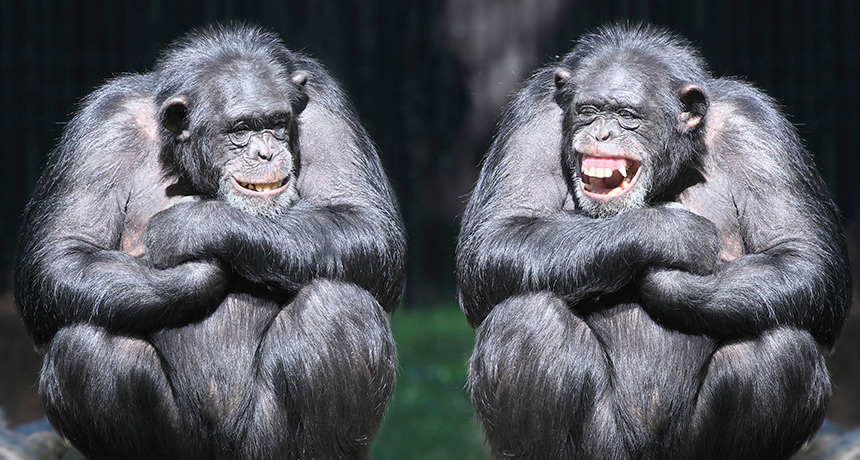How complex is communication between apes?

Apes, including chimpanzees, bonobos, gorillas, orangutans, and gibbons, exhibit diverse and intricate communication methods. Their ability to convey information through vocalizations, facial expressions, body postures, and gestures forms the foundation of their social interactions and relationships.
Vocalizations
Vocalizations and gestures are fundamental components of ape communication, each species exhibiting a distinct array of auditory and visual signals tailored to their social and ecological contexts.
Chimpanzees, for example, employ a wide spectrum of vocalizations that serve various functions within their complex social groups. These vocal signals include hoots, barks, screams, and the renowned “pant-hoot,” a multi-part call used in a range of social situations.
Bonobos, closely related to chimpanzees, showcase a similarly diverse communication system. Their vocal repertoire consists of a broad range of calls and nuanced vocalizations used to convey emotions, maintain social bonds, and coordinate activities. These calls can express contentment, distress, pleasure, or even arousal, showcasing the intricate emotional range these apes convey through vocalizations.
Gestures
Beyond vocalizations, gestures and body language also play a crucial role in ape communication. Chimpanzees and bonobos, in particular, communicate through an extensive range of gestures. These include specific arm and hand movements, head nods, body postures, and facial expressions, each carrying distinct meanings.
For instance, a chimpanzee might perform a “palm-up” gesture to indicate submission or a “beckoning” motion to invite others for grooming or social interaction. Similarly, bonobos use an array of gestures, such as reaching out, embracing, patting, or pointing, to convey their intentions, feelings, and desires within their social groups.
The complexity of these vocalizations and gestures suggest an advanced form of communication that allows apes to convey a rich array of information, express emotions and navigate their intricate social dynamics. Through a combination of vocal and gestural communication, apes demonstrate their remarkable ability to convey nuanced messages and maintain elaborate social relationships within their communities.
Studies and Observations
Scientific studies and observations conducted by prominent primatologists have offered extensive insights into the depth and complexity of ape communication. Among these researchers, Dr. Jane Goodall’s groundbreaking work with chimpanzees at Gombe Stream National Park in Tanzania profoundly transformed our understanding of ape behavior and communication.
Goodall’s observations provided crucial documentation of the intricate social lives and communication patterns of chimpanzees. She meticulously recorded the diverse vocalizations, gestures, and body language employed by these apes to express emotions, convey intentions, establish social hierarchies, and resolve conflicts.
The distinct vocalizations such as “pant-hoots,” “barks,” and “screams” were linked to various social contexts, while gestures like arm waves, grooming, embracing, and touching formed an essential part of their communication repertoire.
Dr. Frans de Waal’s extensive research, primarily focusing on bonobos and chimpanzees, further contributed to our understanding of ape communication. His studies emphasized the importance of non-verbal communication in apes, revealing the significance of gestures, facial expressions, and postures.
De Waal’s work highlighted the nuanced and context-specific nature of ape communication, showcasing the complexity of their social interactions and the rich emotional lives of these animals.
Researchers like Dr. Richard Byrne, who studied the gestures and social cognition of gorillas, and Dr. Birutė Galdikas, who extensively researched orangutans, have also contributed significantly to the understanding of ape communication. Their studies emphasized the diversity of communication methods among different ape species, unveiling unique vocalizations, gestures, and behavioral nuances that play crucial roles in their social dynamics.
Understanding Ape Social Dynamics
Understanding the social dynamics among apes is pivotal in comprehending the complexities of their communication systems. Ape societies are characterized by intricate relationships, hierarchies, and diverse interactions that are shaped by communication strategies.
In many ape species, social structures are organized hierarchically, with individuals positioned in dominance hierarchies that significantly influence interactions within the group. For instance, in chimpanzee societies, a complex dominance hierarchy is established, where individuals engage in various social behaviors to establish and maintain their rank.
Communication plays an important role in these dynamics, with vocalizations, gestures, and body language used to assert dominance and negotiate social relationships.
Ape communication is also integral to conflict resolution and mediation. Ape societies are not without their disputes, and communication aids in managing conflicts and minimizing potential aggression.
For instance, in bonobo communities, a species known for its relatively peaceful social structure, communication through vocalizations, gestures, and displays of empathy helps in diffusing tension and maintaining group cohesion. These gestures and vocal exchanges assist in establishing social harmony, reducing the likelihood of confrontations, and promoting group cohesion.
Sharing knowledge
Communication among apes also serves as a tool for sharing information and knowledge within the group. Whether it’s signaling the discovery of a food source, alerting others to potential dangers, or teaching young ones important skills, effective communication is crucial for the transmission of vital information.
For instance, in chimpanzee communities, the ability to communicate the location of fruiting trees or water sources through specific calls and gestures aids in coordinating group movements and resource utilization.
Moreover, the social dynamics among apes are intricately tied to their reproductive strategies. Communication plays a significant role in mate selection, courtship rituals, and signaling reproductive status. Various vocalizations, displays, and gestures are used during courtship, signaling receptiveness, and maintaining or forming pair bonds within the group.
Significance for Human Evolution
Studying ape communication holds immense significance for understanding human language evolution. The parallels between ape communication and certain aspects of human language, such as the use of gestures and vocalizations to convey meaning, offer valuable insights into the origins and development of human language.
Future Research and Conclusions
While much has been revealed about ape communication, ongoing research continues to explore the depth and nuances of their communication systems. Understanding the complexities of ape communication not only provides insights into their social lives but also broadens our comprehension of the cognitive capacities and evolutionary connections between humans and our closest relatives.










